

Over One in Five Americans Now Own Crypto on Banking Uncertainty
[tta_listen_btn]
Cryptocurrency adoption in the U.S. increased amid fears of a full-blown banking crisis, a new poll finds. According to Morning Consult, 22% of Americans, over one in five, said they owned at least one form of crypto in April, representing a four-percentage-point increase from January.
Not surprisingly, Bitcoin was the most widely held digital asset in April, with 16% of respondents saying they owned some of it. That’s up from 13% a year earlier. Ethereum was the number two asset, with 12% ownership in April 2023, followed by Binance Coin and Tether at 8% each.
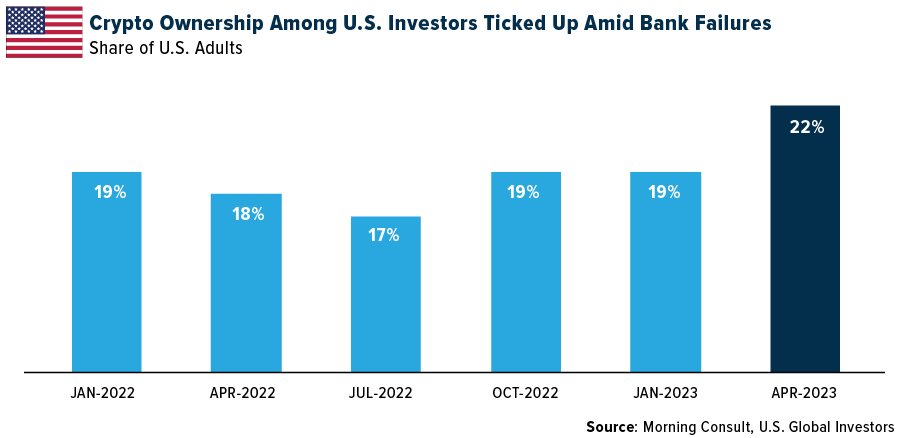
I must point out, though, that many people would take issue with Bitcoin being labeled a “crypto”; even Securities and Exchange Commission (SEC) Chairman Gary Gensler and Commodity Futures Trading Commission (CFTC) Chief Rostin Behnam have both described the world’s biggest digital asset as a commodity.
Traditional Finance Under Pressure
Again, the increase in crypto ownership was likely tied to ongoing market jitters involving the banking industry—in particular, the failures of Silicon Valley Bank (SVB) and Signature Bank and the decapitalization of Credit Suisse and First Republic Bank.
Shares of First Republic plunged close to 75% this week and were trading at around $3.76 on Friday, down from the 52-week high of $219.16, after the San Francisco-based bank reported that depositors yanked out more than $100 billion in the first quarter. Receivership by the Federal Deposit Insurance Corporation (FDIC) now appears likely, and the Federal Reserve is reportedly considering tougher rules for midsize banks.
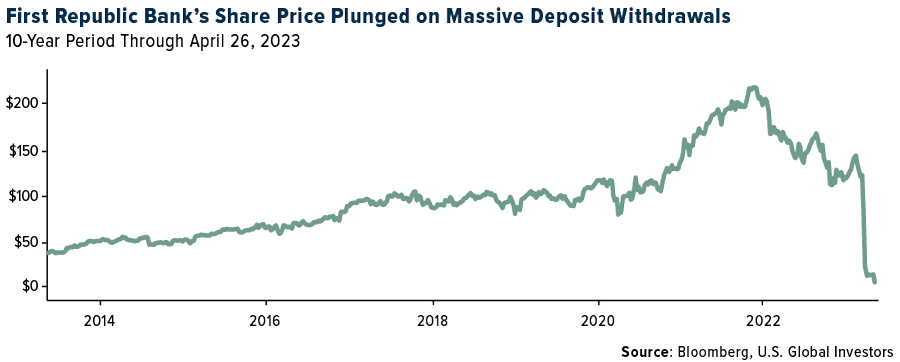
Digital assets—which many investors believe may one day replace traditional financial products and services—were up for the week. The Bloomberg Galaxy Crypto Index gained nearly 6%, while Bitcoin rose as much as 8.5% at its high.
According to the Morning Consult poll, over a quarter of Americans (27%) said they were planning on adding to their Bitcoin holdings in the next month. Twenty-one percent said the same about Ethereum.
But cryptos weren’t the only assets sought by investors as banks looked increasingly perilous. Gold producers have also benefited.
The chart below compares three asset classes’ market value change in billions of dollars since the start of the year. SVB, Signature, Credit Suisse and First Republic have lost a combined $50 billion. Meanwhile, gold producers, as measured by the NYSE Arca Gold Miners Index, have gained over $41 billion in market value, and Bitcoin has added nearly $255 billion, from $318 billion at the start of 2023 to $566 billion today.
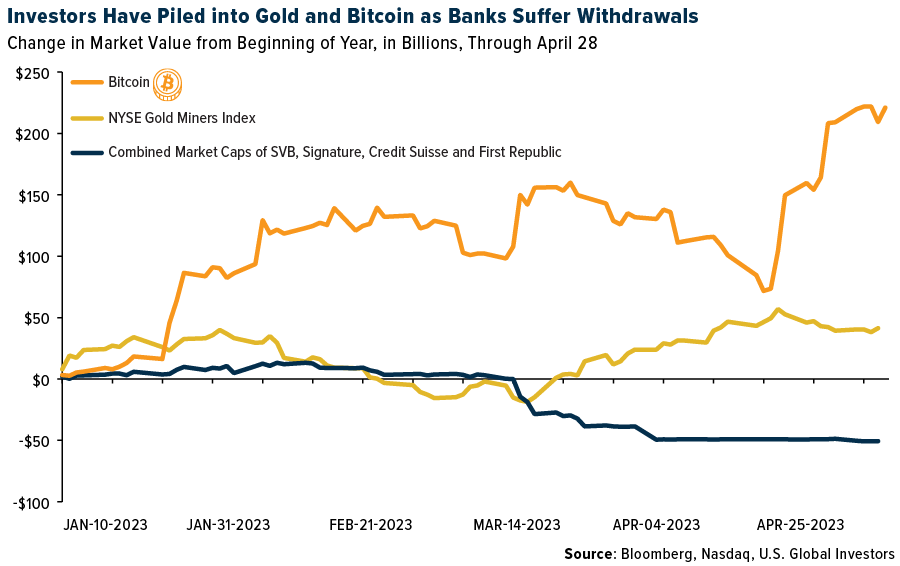
Also supporting gold and Bitcoin is the steadily declining value of the U.S. dollar. The greenback was up marginally on Friday, but fell around a quarter of a percent for the week.
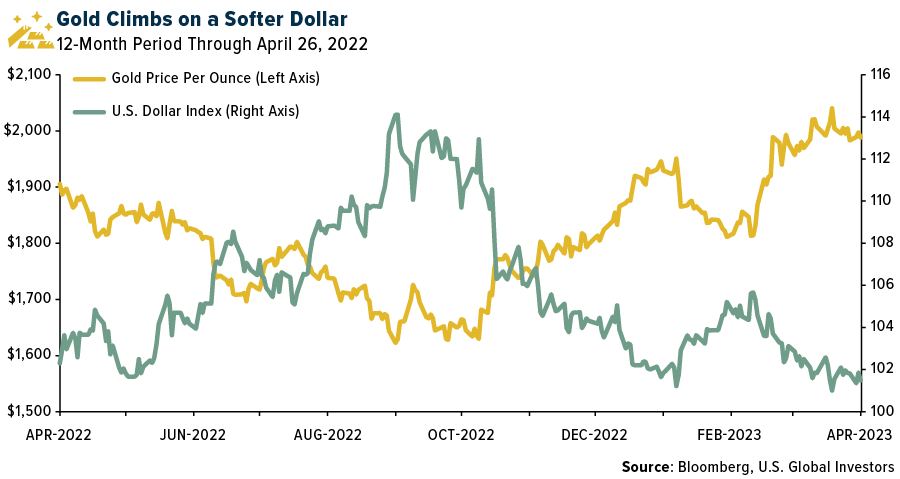
Investors and analysts continue to raise the alarm over the dedollarization trend, which I wrote about in early April. Stephen Jen, CEO of asset management firm Eurizon SLJ and former managing director at Morgan Stanley, says the dollar is losing its reserve currency status at a “stunning” pace. According to him, the dollar has given up about 11% of its market share since 2016 and double that amount since 2008.
Jen appears to blame U.S. sanctions against Russia for the collapse. “Exceptional actions taken by the U.S. and its allies against Russia have startled large reserve-holding countries,” he wrote in a note this week.
Elon Musk echoed the sentiment this week, tweeting: “If you weaponize currency enough times, other countries will stop using it.”
Meanwhile, billionaire investor Stanley Druckenmiller says that shorting the U.S. dollar is his only high-conviction trade right now, adding that he’s never seen such uncertainty in global markets in his 45 years of investing. In the early 1990s, Druckenmiller—then working with George Soros—famously bet against the British pound sterling and made more than $1 billion.
If what Jen, Musk and Druckenmiller say resonates with you, then gold (and Bitcoin) may make sense.
In light of this, I was surprised to see that gold still represents a relatively small fraction of the $266 trillion investable asset market. The global stock of gold bullion—including bars, coins and gold ETFs—that investors currently hold amounts to around $3 trillion, according to the World Gold Council (WGC). This represents around 1% of the total amount invested in all financial assets, from stocks and bonds to alternative assets.
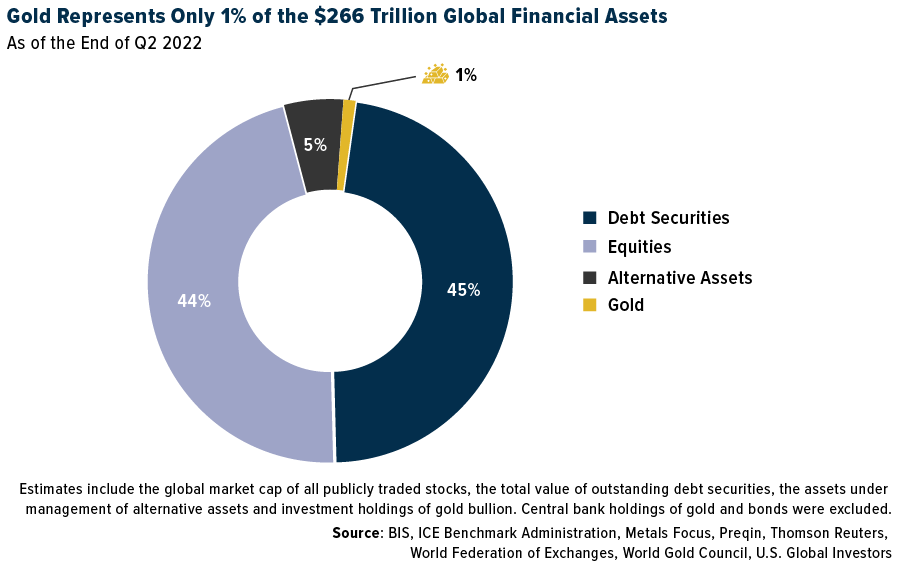
I believe it’s important to have a well-diversified portfolio, and that includes exposure to gold. I’ve always recommended a 10% weighting in gold and gold mining stocks, and with the dollar potentially on uneven footing, my conviction has grown even stronger.

Index Summary
- The major market indices finished mixed this week. The Dow Jones Industrial Average gained 0.86%. The S&P 500 Stock Index rose 0.84%, while the Nasdaq Composite climbed 1.28%. The Russell 2000 small capitalization index lost 1.31% this week.
- The Hang Seng Composite lost 0.80% this week; while Taiwan was down 0.15% and the KOSPI fell 1.68%.
- The 10-year Treasury bond yield fell 14 basis points to 3.43%.
Airlines and Shipping
Strengths
- The best-performing airline stock for the week was Wizz Air, up 8.8%. ANA Holdings revised up third-quarter operating profit guidance to 120 billion yen from 95 billion yen. The Japanese airline said that, in terms of its topline, an overshoot in international passenger revenues was offset by stagnant international cargo revenues, but that operating profits likely came in above its previous guidance on lower-than-expected expenses (due to yen appreciation, lower fuel costs, tight cost management).
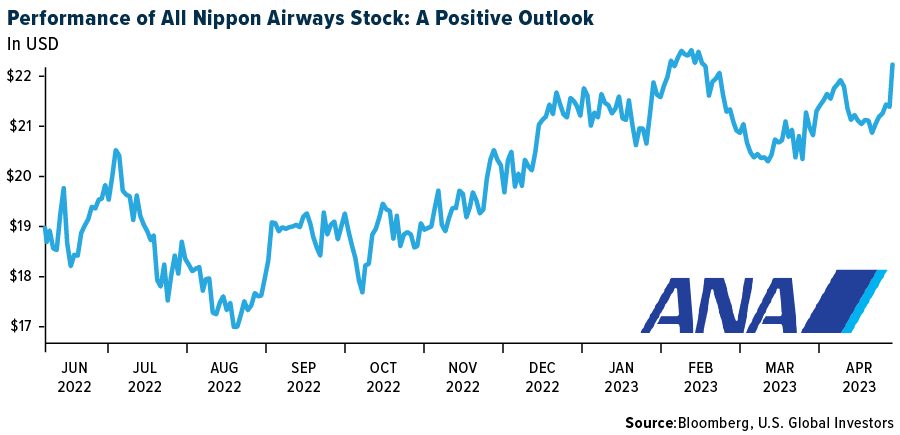
- It has been a good start to the year for Switzerland-based logistics company Kuhne + Nagle, with third-quarter EBIT (earnings before interest and taxes) of 612 million Swiss francs, 18% ahead of company-compiled consensus. The beat was almost entirely driven by surprisingly high pricing in sea freight. Airfreight yield and EBIT declines were in line with consensus.
- International net sales reaccelerated slightly with net sales up 7.4% versus 2019, compared to +6.0% last week. Meanwhile, domestic net sales fell 5.4% versus 2019. Strong international trends were underscored by United Airlines’ second-quarter guidance announced last week, with strong transatlantic demand offsetting softer domestic bookings. Further, there has been a bounce back in overall large corporate sales to -20.7% versus 2019 compared to -27.7% last week and -26.3% the prior four weeks.
Weaknesses
- The worst-performing airline stock for the week was Bombardier, down 15.4%. European airline bookings as a portion of 2019 levels declined 22 points to -17%, driven by a week-over-week drop in bookings as well as continued Easter timing impact with a sharper drop in international bookings. Total net sales were down 14% on a week-over-week basis. Intra-Europe net sales were down 17 points to -15% versus 2019 and were 9% lower week-over-week.
- UPS pivoted to the low end of its of its 2023 targets for revenues and operating margin. Volume declines accelerated through the first quarter from a challenging macro backdrop, with consumer shifts to services from goods.
- Volaris reported worse-than-expected results, in a seasonally weaker quarter. Top line revenue was $731 million, 4% below Bloomberg consensus, while earnings before interest, taxes, depreciation and amortization (EBITDA) came in at $88 million, compared to consensus of $106 million. The miss was mostly driven by 15% lower-than-anticipated yield and 5% higher-than-expected cost per available seat mile (CASM).
Opportunities
- One of the continued tailwinds from which the Canadian airline sector benefits is higher pent-up demand to travel, as measured by the recovery rate versus 2019 levels. Canada’s traffic has yet to fully recover (the U.S. has). Household savings rates have not corrected as much as in the U.S., which is also an incremental positive for travel spend. Air Canada is in the earlier innings of this recovery ball game, and this reduces the risk around its near- to medium-term earnings trajectory.
- The tanker market has been robust as oil demand continues to grow, and the Russian/Ukraine conflict ton-mile demand remains elevated. Importantly, fleet growth has been minimal and should remain benign as new vessel orders have been virtually nonexistent. However, the recent surprise OPEC+ cuts, which are scheduled for May through December, could provide a modest headwind, particularly for crude tankers. Given a backdrop for continued demand growth and effectively no supply growth, tanker rates are likely to remain strong.
- Category 1 restoration opens up multiple positive opportunities for Volaris. The carrier will again be able to grow capacity between the U.S. and Mexico, where base fare yields are much higher than on domestic Mexico routes and the airline has a material cost advantage over competitors on those lanes. Pivoting aircraft into the U.S. market will also alleviate surplus capacity that is pressuring yields in the domestic Mexico market. Finally, Volaris will be able to reactivate its codeshare with Frontier, which will allow the carrier to further grow its international business and expand its U.S. point of sale presence.
Threats
- According to J.P Morgan, domestic booked revenue continues to exhibit meaningful year-over-year deceleration for the second quarter, while international booked revenue remains robust. As previously noted, they do not view this as definitive evidence of cooling travel demand; rather, they believe it largely reflects geographic trends beginning to normalize after last year’s period of significant abnormality.
- Morgan Stanley had previously seen the possibility of a short-term rebound in spot container shipping rates on North American routes, with the renewal period for annual pricing contracts approaching (typically in May). However, this past week, rates actually turned down sharply. The bank thinks the impact of GRIs (general rate increases) on North American routes will prove to be only short-lived. In their view, this attests to the fragility of the supply/demand balance for container shipping at present.
- Hawaiian Air introduced June quarter guidance across various metrics that implied an adjusted loss per share estimate of $0.75, materially beneath FactSet consensus of $0.50, which incorporated a significantly better revenue outlook. Additionally, while management noted a lower-than-planned summer schedule to Japan and cost headwinds driven by aircraft on the ground due to engine constraints, the company reiterated its 2023 capacity and unit cost outlook ranges.
Luxury Goods and International Markets
Strengths
- The market capitalization of LVMH exceeded $500 billion, officially putting it among the world’s 10 largest companies by market value. LVMH is the first European company able to grow to this size. Luxury stocks, many of them listed on the Paris Stock Exchange, have surged this year, outpacing other major markets.
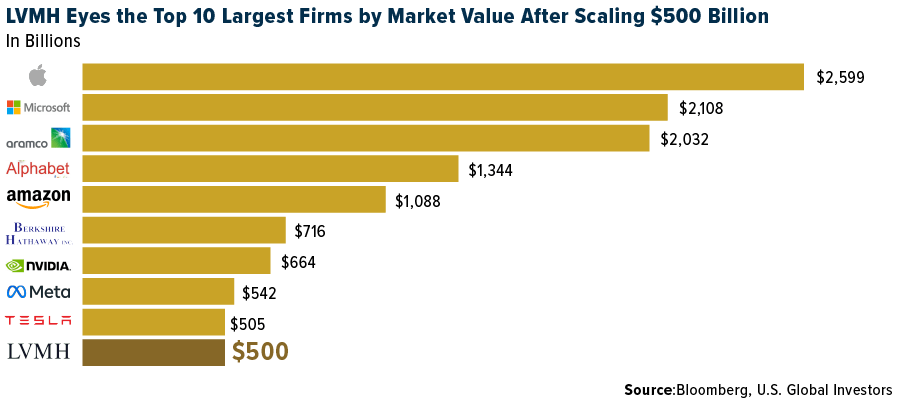
- According to Bloomberg, Swiss watch sales remain strong. Exports of Swiss watches increased by 14% in March with Hong Kong, China and Singapore orders showing the first sizable monthly uplift after zero-Covid policies ended in January. Sales in Asia were up 17% (mostly due to stronger buying in China), followed by Europe at 12% and the Americas at 7%.
- Lucid, a Chinese electric car producer, was the best-performing S&P Global Luxury stock for the week, gaining 12.8%. The company is preparing its second EV model, the Gravity SUV. which is undergoing testing in the United States. Production of the new model should start next year.
Weaknesses
- Revenue at Gucci, which generates about two-thirds of revenue for Kering, rose 1% while analysts were expecting a gain of about 2.7%. This company’s first-quarter results were below LVMH’s and Hermes’, which recently reported double-digit sales growth. Kering’s revenue, which includes e-commerce sales, slid 18% in North America, while Asia Pacific grew 10% in the quarter, the company said.
- Trading of First Republic Bank stock was halted in the U.S. as news emerged that the bank lost almost $72 billion in deposits during the first quarter, despite a $30 billion infusion from 11 banks on March 16. Expectations for further interest rate increases from the Federal Reserve, which is set to announce its next rate decision on May 3, continue to add stress to the banking sector.
- Faraday Future Intelligence was the worst-performing S&P Global Luxury stock for the second week in a row, losing 21.8% in the past five days. Shares continue to decline despite the company recently announcing production completion of its first car, the first long-awaited FF91.
Opportunities
- Golden Week is a busy travel week in Asia, and this year, more people will finally be allowed to take a trip after the Chinese government removed the zero-Covid policy and reopened the borders. An estimated 9 million air passenger trips will be made during the May Day holiday, compared with 6.9 million in 2019, according to CCTV. Overseas ticket searches for Golden Week also exceed that of 2019. The Labor Day Golden Week holiday begins on April 29.
- London is set to become the city with the most hotel rooms in the world outside of China, surpassing Las Vegas and Tokyo. Shanghai, with a population of more than 26 million, has about 346,000 hotel rooms, while Beijing has more than 323,500, according to STR, a hotel market data company. It is expected that London will offer 183,600 rooms in the next five years, a projected 18% increase from its current total, STR says. Also, rooms in London earn more money now than before Covid. In December, the average room was going for 207 GBP ($258), 31% above the pre-pandemic levels.
- China will report PMIs next week, and they will most likely continue to climb, showing a positive effect of the market reopening. In the United States, the Manufacturing PMI will most likely remain above the 50-mark, in expansionary territory. On the other hand, the eurozone manufacturing PMI will very likely remain below the 50-mark, in contraction territory.
Threats
- Following the banking trouble in the United States, the European Central Bank (ECB) is asking lenders about their exposure to rapidly rising interest rates, trying to investigate how much risk may spread outside of the banking sector. Last year, the ECB asked banks to model the impact of a two-percentage-point increase in borrowing costs on the value of their bond portfolios (lower than the current borrowing cost of 3.5%). Eurozone banks own 2.8 billion euros in government bonds, and not all unrealized losses may be accounted for.
- European stocks have rallied this year as Europe avoided an energy crisis over the winter after Russia unexpectedly attacked Ukraine last year. The 10 largest European companies now have a market capitalization in excess of $3 trillion, and luxury giant LVMH is the largest by market cap, with $500 billion in assets. However, bank trouble in Europe may spread to other sectors of the continent, pushing equities lower and setting the stage for an economic recession.
- Bloomberg Economists expect eurozone inflation to be reported higher next week, predicting the year-over-year consumer price index (CPI) reaching 7.1% in April, up from 6.9% in March. Food prices may remain elevated in Europe for longer. Next week, the ECB will also make a rate decision. It is expected that a hike of 25-50 basis points will be announced. Inflation will be released on May 2, and the ECB decision will follow May 4.

Energy and Natural Resources
Strengths
- The best performing commodity for the week was molybdenum, rising 11.06% as Freeport-McMoRan says supplies are limited as they are one of the world’s biggest producers of molybdenum. Prices in China have dropped about 50% from their February highs as purchases were curtailed. UBS hosted a refining expert, who was positive on gas cracks as 1) domestic refining system will operate at near capacity, 2) gas inventories at 6% lower than last year, and 3) potential supply disruptions (i.e., hurricanes) heading into driving season.
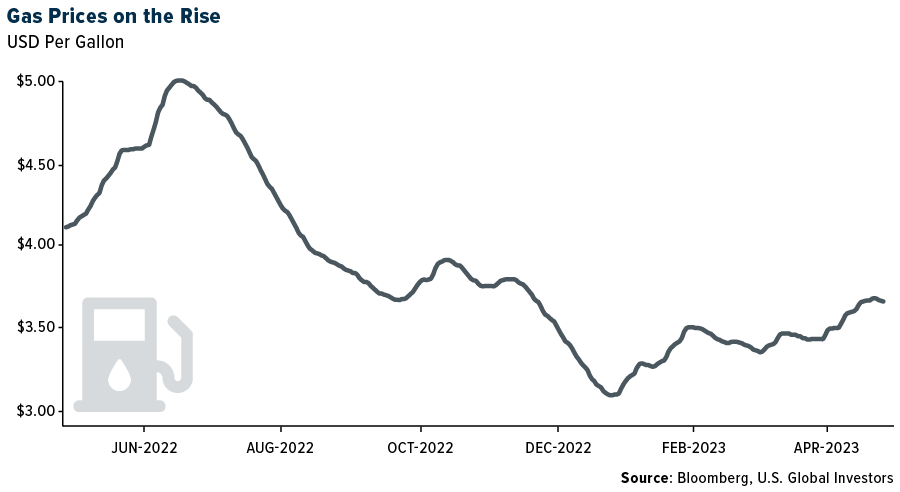
- Germany has committed to closing all coal-fired power plants by 2038, with a 2030 deadline in certain regions. By the end of the decade, Germany aims to generate 80% of its electricity from renewable sources. The country’s transition to renewables has been gradual, with significant progress made in recent years. However, there are concerns about the adequacy of Germany’s energy supply during the transition, particularly during periods of peak demand, and some argue that natural gas is not a long-term solution.
- The Department of Energy reported gasoline inventory draw of 2.4 million barrels versus consensus expectations of 1.15 million barrels and API estimates of 1.92 million barrels. Products draw data was bullish versus consensus and API expectations. Refining utilization is at 91.3%. Implied demand numbers indicate that gasoline demand was up 8.8% year-over-year.
Weaknesses
- The worst performing commodity for the week was lumber, dropping 11.96% on news that March pending home sales are down 5% from February. Iron ore slumped to its lowest since early December, as persistently weak demand continued to weigh on overall market sentiment and capped a potential recovery.
Copper is on the brink of its worse month since June, and U.S. crude oil prices are heading for their sixth monthly decline. - Germany’s final three nuclear power plants were shut down on April 15. Nuclear power has long been a contentious topic in Germany, with some advocating for a transition away from what they view as an unsustainable and hazardous technology that diverts attention from accelerating renewable energy. However, others view the shutdown of nuclear plants as shortsighted, as it eliminates a reliable source of low-carbon energy at a time when significant reductions in greenhouse gas emissions are required.
- While most of the focus in the battery metal space has been on the relentless lithium sell-off so far this year, the oversupplied cobalt market is in a worse position, with limited scope for supply-demand fundamentals to turn around any time soon. At $17 per pound, the European cobalt metal price is down 58% from its June peak. While the metal price has been steady since mid-February, cobalt hydroxide—the intermediate feedstock product that China typically imports—remains under pressure.
Opportunities
- As U.S. production continues to grow, Platts is now forecasting a 5.6% increase in propane supply from 2022 levels. U.S. propane prices could drop to levels that compete with ethane as the preferred feedstock in flexi-crackers. Between 100 and 150 thousand barrels per day of switching between ethane and propane can occur in the U.S. petrochemical industry, which could result in ethane being rejected back into the U.S. natural gas stream, further putting pressure on end-October storage balances.
- Liquified natural gas (LNG) prices have been falling. The silver lining of softer prices is that there has begun to be a reversal of demand destruction in developing/growth markets. Demand may grow 6% annually through the end of the decade, and over the next 18 months, demand is likely to surpass supply, driving up prices to around $20 per British thermal units. After declining ~1% year-over-year in the first quarter, total Asia imports have increased so far in the second quarter. Notably, over the past few weeks, India imports have risen 21% and China 13% year-over-year, although this has been offset by weakness in Japan (-21%) and South Korea (-7%).
- At the sector level, total free cash flow (FCF) for energy falls sequentially 22%, confirming the second quarter of 2022 as probably the highest sector FCF for this cycle. The exception is gas exploration and production where the best quarters may be still ahead. The recent rebound in oil sector performance has lifted some valuations back within the recent trading range with few positive catalysts expected from first-quarter results to reset expectations of value.
Threats
- At the start of the year, Morgan Stanley had hoped that China’s reopening would stimulate increased demand for chemical products and trigger some restocking, which in turn would move spreads higher from their very depressed levels. What has instead played out is that even with a strong restock in March, supply has been readily available, and damped any potential spread recovery. This, therefore, pushes out the recovery for upstream chemical markets and brings into question the magnitude of the second-half recovery baked into consensus expectations.
- Lithium is by far the highest source of earnings for SQM and Albemarle, though SQM only has Chilean lithium production (until its Australian JV commissions later this decade), whereas for ALB, it’s about half of its lithium production currently. Because of issues dealing with Chile, Chilean lithium expansions and additions are minimal currently. Chilean lithium production goes from about one-third of global production now to 10%-15% by 2030.
- Last weekend, Chilean newspaper La Tercera published a long interview with Mr. José Miguel Benavente, the Chief of CORFO, Chile’s government organization that, among other things, has the exploration rights to the Salar de Atacama, which is leased to SQM and Albemarle for their lithium operations. CORFO and Mr. Benavente played an important part in the construction of the lithium policies released last Thursday.
Bitcoin and Digital Assets
Strengths
- Of the cryptocurrencies tracked by CoinMarketCap, the best performer for the week was Render Token, rising 38.96%.
- Bitcoin’s rebound could be just the start of a rally that may take it past $50,000 next year courtesy of a process known as halving, which curbs the supply of new tokens. The quadrennial event is due next around April 2024 and part of the process of capping Bitcoin supply at 21 million. The token hit records after each of the last three halvings, writes Bloomberg.
- Tether’s stablecoin is on the verge of recovering all of the market value lost in the wake of the collapse of algorithmic rival TerraUSD less than a year ago. The recovery is a testament to the dominant role Tether plays in crypto as a means for conducting transactions and storing value.
Weaknesses
- Of the cryptocurrencies tracked by CoinMarketCap, the worst performing for the week was PancakeSwap down 19.35%.
- Bitcoin reached an almost four-week low, with the asset continuing to lose momentum since breaking above $30,000 earlier this month for the first time since June. Now $25,000 comes into fresh focus, writes Bloomberg.
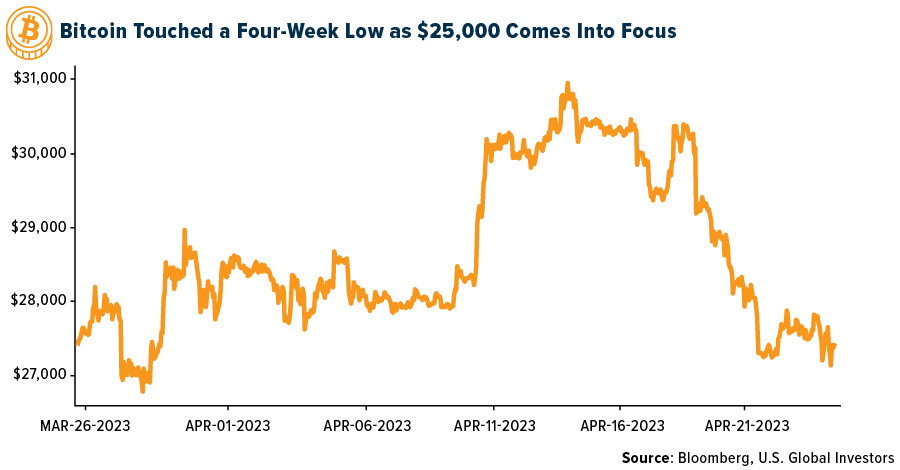
- Coinbase Global Inc. is delivering a last warning to the Securities and Exchange Commission (SEC) that it won’t be simple to take down. According to Chief Legal Officer Paul Grewal, the corporation would prefer not to sue. In an interview, he remarked, “We didn’t pick this fight.” When asked about the company’s answer, an SEC spokeswoman said the agency doesn’t disclose investigations until civil charges are filed.
Opportunities
- Zimbabwe needs $100 million of gold to kick-start its proposed bullion-backed digital currency, as the southern African nation makes another attempt to stabilize its floundering dollar. The central bank will rely on gold reserves, which it has been accumulating to support the initiative and stem the local currency’s volatility.
- Polygon Labs announced a partnership with Google Cloud this week. As part of the agreement, the cloud computing behemoth will provide assistance for Polygon. Furthermore, Google Cloud will provide infrastructure to enable Polygon zkEVM.
- Crypto.com today announced a partnership with Samsung for the latest Crypto.com App update, Version 3.158.1, which includes an optimized experience for Samsung Galaxy Z Fold smartphones, including the latest Galaxy Z Fold4. The advanced app features will improve productivity, multitasking and trading and analyzing capabilities. Crypto.com is the first cryptocurrency platform to provide a personalized experience for Galaxy Z Fold devices.
Threats
- South Korea indicted Terraform Labs co-founder Daniel Shin along with nine others on multiple charges, including violations of capital markets law related to Terra cryptocurrency project, writes Bloomberg.
- The U.S. has charged a North Korean bank official over his alleged involvement in laundering cryptocurrency stolen on behalf of Pyongyang. Sim Hyon Sop, a representative of the North Korean Foreign Trade Bank, is suspected of conspiring with cryptocurrency traders to use stolen funds to buy goods for North Korea, writes Bloomberg.
- Bank turbulence impacted the market again this week, and as blockchains keep money in traditional banks, this turbulence could impact those as well. The financial system is more connected than many people realize.

Gold Market
This week gold futures closed the week at $1998.10, up $7.60 per ounce, or 0.38%. Gold stocks, as measured by the NYSE Arca Gold Miners Index, ended the week lower by 0.44%. The S&P/TSX Venture Index came in off 0.13%. The U.S. Trade-Weighted Dollar fell 0.19%.
Strengths
- Gold prices in India have soared to the highest ever, damping the outlook for demand in the world’s second-biggest consumer. That was especially apparent during the day of Akshaya Tritiya at the weekend, which is considered one of the most auspicious times of the year to buy gold by the nation’s majority Hindu population.
Weaknesses
- The worst-performing precious metal for the week was palladium, down 7.12%. Gold prices were held in check this week with the personal consumption expenditures index, excluding food and energy, rising 4.6% in March from a year earlier, far above the 2% Fed target for underlying inflation. The Fed is meeting next week to consider its options.
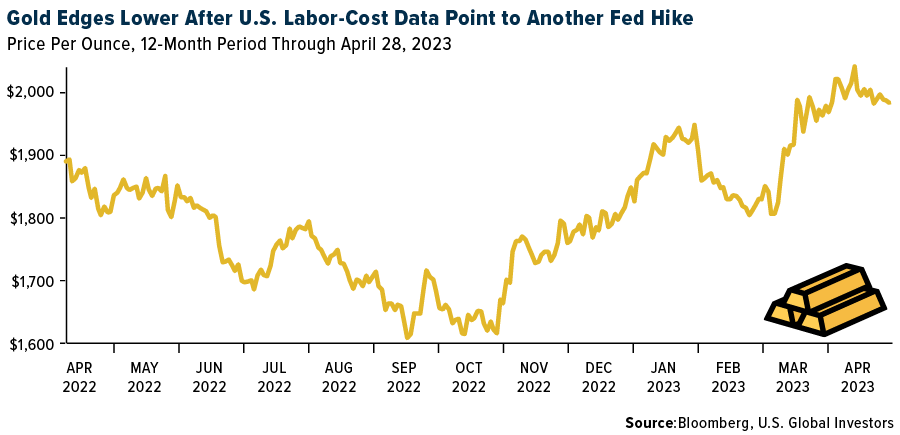
- Royal Gold’s 2023 guidance is for gold sales of 320-345k ounces, where midpoint targets are 9% below consensus estimates of 364k ounces. Of the 30k ounces negative variance versus consensus, approximately 10k ounces are attributable to gold production. The remaining 20k ounces negative variance is attributable to non-gold production.
- Newcrest announced relatively weak fiscal third-quarter operating results. Gold and copper production were 10% and 18% lower, respectively, than consensus, at 6% higher cash costs and 10% lower all-in sustaining costs (AISC). 2023 operating guidance was maintained and capital guidance was decreased by 24% due to lower stripping and deferral on the timing of capital spending on various projects.
Opportunities
- Since bottoming at $1,622 per ounce in September 2022, gold’s pronounced 20%+ run-up to the $2,000-per-ounce level in recent months has brought some amount of relief to an otherwise difficult market for junior explorers and developers. In spite of this relief, valuations for the group remain trading at a significant discount to producer peers, which we see as reflective of lingering fears around cost and capital inflation, along with the perceptions/realities associated with executing on project development successfully as a junior.
- RBC continues to believe explorer/developer mergers and acquisitions will remain muted in the near term. This is the result of not only depressed valuations among the producers but also a focus among these producers on maintaining financial discipline while reducing project execution risk driven by the persistent inflationary environment. Longer term, as M&A inevitably comes down, and larger producers begin to focus on growth once more, they expect one of the main emerging themes to be the acquisition of permitted, shovel-ready projects that can produce material ounces (>200k ounces) over 10+ years. A higher gold price could accelerate transactions.
- The Wall Street Journal reported that some weary Bitcoin investors are starting to chase a shiny new object – gold! Bludgeoned by the instability of the unregulated cryptocurrency markets, some investors in crypto who wanted their money independent of banks and national currencies have now turned to gold. Web searches for “crypto” and “gold” in the same query are the highest since 2018, and Google searches on “how to buy gold” have hit their highest level this month, according to Google Trends data, which covers two decades of historic searches.
Threats
- In India, unless domestic gold prices drop by 5-10%, demand from April to June will be weak and overall sales this year will be flat to negative compared with 2022, Sheth said. “You already have a washed-out January-March quarter, and the current quarter is also weighed down by high prices,” he said. Consumption was 774 tons last year, according to World Gold Council (WGC) data.
- The ongoing inflationary environment remains an overarching theme within the gold space, raising concerns among investors about the potential impact inflation will have on project economics. Companies who have entered construction are facing increased capital and operating costs, which could place them in a situation to seek additional financing at a time of high interest rates and discounted valuations.
- Illegal mining by “zama zamas,” a Zulu term that loosely translates to “take a chance” (as you are literally putting your life at risk going into old mining shafts and mining remanent gold), is up. Sibanye Stillwater noted this week that there is a “material risk” to its South African operations. In 2017, the number of illegal mining incidents the company had to deal with was 515, but with a sharp crackdown in 2018, Sibanye reduced the incidents to 92. However, the number of incidents in 2022 was 363, double the prior year’s count. They are literally having to address a new illegal mining incident every day.


U.S. Global Investors, Inc. is an investment adviser registered with the Securities and Exchange Commission (“SEC”). This does not mean that we are sponsored, recommended, or approved by the SEC, or that our abilities or qualifications in any respect have been passed upon by the SEC or any officer of the SEC.
This commentary should not be considered a solicitation or offering of any investment product. Certain materials in this commentary may contain dated information. The information provided was current at the time of publication. Some links above may be directed to third-party websites. U.S. Global Investors does not endorse all information supplied by these websites and is not responsible for their content. All opinions expressed and data provided are subject to change without notice. Some of these opinions may not be appropriate to every investor.
Holdings may change daily. Holdings are reported as of the most recent quarter-end. The following securities mentioned in the article were held by one or more accounts managed by U.S. Global Investors as of (03/31/2023):
LVMH Moet Hennessy Louis Vuitton
Apple Inc.
Amazon.com Inc.
Tesla Inc.
Kering SA
Hermes International
easyJet PLC
Freeport-McMoRan Inc.
ANA Holdings Inc.
United Airlines Holdings Inc.
United Parcel Service Inc.
Air Canada
Hawaiian Holdings Inc.
Wizz Air Holdings Plc
Bombardier Inc.
Lucid Group Inc.
Harmony Gold Mining Co. Ltd.
Pan American Silver Corp.
Royal Gold Inc.
Newcrest Mining Ltd.
Sibanye Stillwater Ltd.
*The above-mentioned indices are not total returns. These returns reflect simple appreciation only and do not reflect dividend reinvestment.
The Dow Jones Industrial Average is a price-weighted average of 30 blue chip stocks that are generally leaders in their industry. The S&P 500 Stock Index is a widely recognized capitalization-weighted index of 500 common stock prices in U.S. companies. The Nasdaq Composite Index is a capitalization-weighted index of all Nasdaq National Market and SmallCap stocks. The Russell 2000 Index® is a U.S. equity index measuring the performance of the 2,000 smallest companies in the Russell 3000®, a widely recognized small-cap index.
The Hang Seng Composite Index is a market capitalization-weighted index that comprises the top 200 companies listed on Stock Exchange of Hong Kong, based on average market cap for the 12 months. The Taiwan Stock Exchange Index is a capitalization-weighted index of all listed common shares traded on the Taiwan Stock Exchange. The Korea Stock Price Index is a capitalization-weighted index of all common shares and preferred shares on the Korean Stock Exchanges.
The Philadelphia Stock Exchange Gold and Silver Index (XAU) is a capitalization-weighted index that includes the leading companies involved in the mining of gold and silver. The U.S. Trade Weighted Dollar Index provides a general indication of the international value of the U.S. dollar. The S&P/TSX Canadian Gold Capped Sector Index is a modified capitalization-weighted index, whose equity weights are capped 25 percent and index constituents are derived from a subset stock pool of S&P/TSX Composite Index stocks. The NYSE Arca Gold Miners Index is a modified market capitalization weighted index comprised of publicly traded companies involved primarily in the mining for gold and silver. The S&P/TSX Venture Composite Index is a broad market indicator for the Canadian venture capital market. The index is market capitalization weighted and, at its inception, included 531 companies. A quarterly revision process is used to remove companies that comprise less than 0.05% of the weight of the index, and add companies whose weight, when included, will be greater than 0.05% of the index.
The S&P 500 Energy Index is a capitalization-weighted index that tracks the companies in the energy sector as a subset of the S&P 500. The S&P 500 Materials Index is a capitalization-weighted index that tracks the companies in the material sector as a subset of the S&P 500. The S&P 500 Financials Index is a capitalization-weighted index. The index was developed with a base level of 10 for the 1941-43 base period. The S&P 500 Industrials Index is a Materials Index is a capitalization-weighted index that tracks the companies in the industrial sector as a subset of the S&P 500. The S&P 500 Consumer Discretionary Index is a capitalization-weighted index that tracks the companies in the consumer discretionary sector as a subset of the S&P 500. The S&P 500 Information Technology Index is a capitalization-weighted index that tracks the companies in the information technology sector as a subset of the S&P 500. The S&P 500 Consumer Staples Index is a Materials Index is a capitalization-weighted index that tracks the companies in the consumer staples sector as a subset of the S&P 500. The S&P 500 Utilities Index is a capitalization-weighted index that tracks the companies in the utilities sector as a subset of the S&P 500. The S&P 500 Healthcare Index is a capitalization-weighted index that tracks the companies in the healthcare sector as a subset of the S&P 500. The S&P 500 Telecom Index is a Materials Index is a capitalization-weighted index that tracks the companies in the telecom sector as a subset of the S&P 500.
The Consumer Price Index (CPI) is one of the most widely recognized price measures for tracking the price of a market basket of goods and services purchased by individuals. The weights of components are based on consumer spending patterns. The Purchasing Manager’s Index is an indicator of the economic health of the manufacturing sector. The PMI index is based on five major indicators: new orders, inventory levels, production, supplier deliveries and the employment environment. Gross domestic product (GDP) is the monetary value of all the finished goods and services produced within a country’s borders in a specific time period, though GDP is usually calculated on an annual basis. It includes all private and public consumption, government outlays, investments and exports less imports that occur within a defined territory.
The S&P Global Luxury Index is comprised of 80 of the largest publicly traded companies engaged in the production or distribution of luxury goods or the provision of luxury services that meet specific investibility requirements.





























